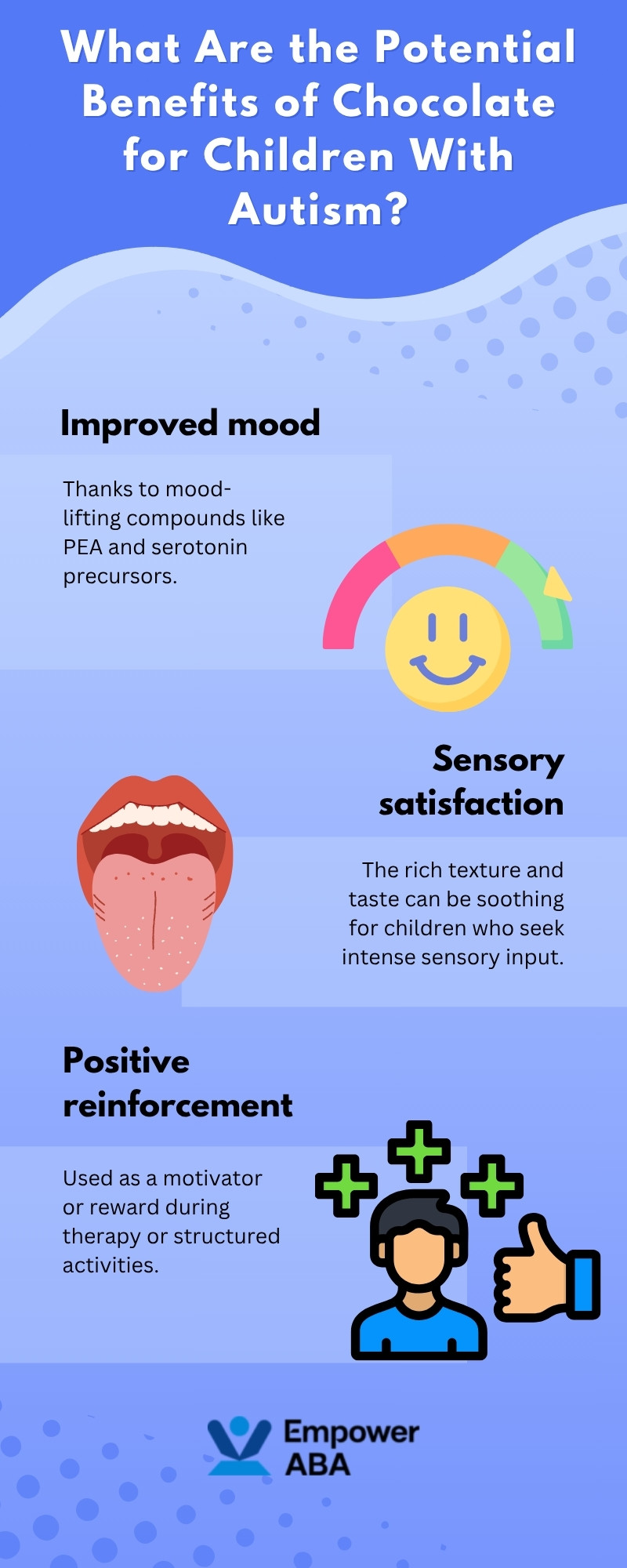Key Points:
- While chocolate isn’t a treatment for autism, certain components in chocolate may support mood and sensory experiences for children with autism.
- Understanding the sensory and behavioral needs of children with autism can help parents make informed choices about treats like chocolate.
- Balanced, mindful use of chocolate, combined with personalized care like ABA therapy, can support overall well-being in children with autism.
Raising a child on the autism spectrum often brings a long list of questions—big and small. One of the surprisingly common ones? Chocolate. Parents wonder whether it’s okay, beneficial, or possibly problematic for their child with autism. Chocolate is everywhere, after all—at school events, birthdays, even as simple rewards. But how does chocolate actually affect kids with autism? Is it helpful or harmful?
Can Chocolate Help Children With Autism?
Yes and no. While chocolate isn’t a cure or formal treatment for autism, it can offer sensory and emotional benefits when used mindfully.
Chocolate and autism are two words that rarely appear together in medical discussions, but many parents have noticed how their child reacts—positively or negatively—to chocolate. Let’s break down the science and real-world experience behind these observations.
Understanding Chocolate: What’s Inside That Matters?
Chocolate is more than just a sweet treat—it’s a complex mix of compounds that can influence the brain and body in unique ways.

The 4 Key Ingredients in Chocolate
Chocolate contains several bioactive ingredients that may interact with brain chemistry, especially in children with autism who often have sensitive systems. These include:
- Theobromine and caffeine: Mild stimulants that can affect focus and energy levels.
- Phenylethylamine (PEA): Often called the “love drug,” it can boost mood by encouraging dopamine release.
- Magnesium: A mineral many children with autism are low in, important for nerve and muscle function.
- Flavonoids: Antioxidants that may help with inflammation and support brain health.
These elements, especially when found in dark chocolate, have been linked to better mood regulation, reduced anxiety, and even enhanced cognitive function in some studies. However, results vary by individual, much like the effects of certain supplements and gut health strategies explored in Which Probiotics are Safe and Effective for Autism?
What are the Potential Benefits of Chocolate for Children With Autism?
Not every child with autism will benefit from chocolate, but under the right conditions, it may offer support in key areas.
Potential Positive Effects
Some parents and therapists report that chocolate can help children with autism in the following ways:

When used appropriately, chocolate can become a simple tool to promote positive behavior or soothe overstimulation.
What are the Risks or Downsides?
Every child is different, and for some, chocolate might bring more challenges than benefits.
3 Things to Watch For
Before adding chocolate to your child’s diet or routine, consider the following potential issues:
- Sensitivity to sugar or caffeine: This can lead to hyperactivity, mood swings, or difficulty sleeping.
- Allergies or food intolerances: Some children are sensitive to dairy, soy, or other ingredients in chocolate.
- Behavioral triggers: For certain children, chocolate might increase irritability or obsessive behaviors.
Always observe your child’s individual reaction and consider talking to a healthcare provider or therapist for tailored advice.
Practical Tips for Introducing Chocolate
If you’re considering chocolate as part of your child’s routine, it helps to take a thoughtful and structured approach.
How to Use Chocolate Mindfully
Start small and follow these guidelines to safely explore chocolate with your child:
- Choose high-quality chocolate: Opt for dark chocolate with minimal additives for a more nutritious option.
- Limit portion size: A small piece is often enough to provide benefits without overloading on sugar.
- Use as a reward tool: Pair chocolate with positive behaviors or therapeutic milestones to reinforce progress.
- Watch and record reactions: Track behavior, sleep, and digestion after chocolate exposure to identify patterns.
- Avoid late-day treats: Prevent any potential interference with nighttime rest by offering chocolate earlier in the day.
Parents can use chocolate as a creative and strategic tool—but always with moderation and care.
Beyond Chocolate: Supporting Autism With Evidence-Based Care
Chocolate can be one small piece of the puzzle, but lasting progress comes from consistent, structured support tailored to each child’s needs.
The Role of ABA Therapy
Applied Behavior Analysis (ABA) therapy remains one of the most trusted and effective approaches for children on the autism spectrum. It helps by:
- Teaching essential life skills step-by-step
- Reducing problem behaviors
- Promoting communication, attention, and learning
ABA programs are personalized, goal-oriented, and designed to fit into your child’s daily life. Combining thoughtful lifestyle choices—like food sensitivities or sensory preferences—with professional support like ABA therapy creates a well-rounded approach to care.
Empower ABA – ABA Therapy in New York, New Jersey, and Virginia
Every child with autism deserves compassionate, individualized care—and that’s where Empower ABA comes in. If you’re navigating the challenges and joys of parenting a child on the autism spectrum, Empower ABA offers expert-led ABA therapy in New York, New Jersey, or Virginia tailored to your child’s unique needs.
We are here to support your journey. Our therapy programs are built on evidence, empathy, and a deep commitment to helping children thrive.
Empower ABA understands the delicate balance of everyday choices, from treats like chocolate to daily routines, and how they connect to long-term progress. If you’re ready to take the next step in supporting your child’s development, get in touch with us today!

